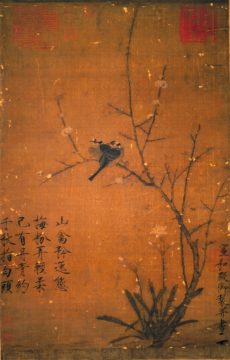by Leanne Ogasawara

山禽矜逸態 梅紛弄輕柔 已有丹青約 千秋猜白頭
Mountain birds, proud and unfettered
Plum blossoms, pollen scattering softly
This painting but a promise
Of a thousand autumns to come
- The Painting
Nine-hundred years ago, a Chinese emperor painted a picture of a pair of birds in a plum tree –to which he then inscribed a poem in calligraphy of unsurpassed elegance, in a style all his own. It is interesting to consider that very few new styles of calligraphy emerged in China after the sixth century. But Emperor Huizong (r. 1101-25), while still only a young prince, created his own way of writing. Later dubbed the “slender gold” (瘦金體), it has been described by admirers as being writing like “floating orchid leaves,” or like “bamboo moving in the wind.” Or even more aptly, like “the legs of dancing cranes.” Detractors complained that the “skinny legs” are “too scrawny” to hold up the body, or “too bony”, like “a starving student in misfitting clothing.”
Whether one is partial to his characters or not, the fact remains that the “slender gold” style is probably the most famous –or maybe even the only– example in Chinese history of an emperor creating his own style of writing.
We see his four-line poem on the bottom left of the ink painting. Also there on the right of the delicately-drawn narcissus flowers, the emperor has signed his work –again, in that exquisite calligraphy like dancing cranes: “In the Xuanhe Hall, the Emperor drew this [picture].”
And what of the picture?
Well, we see two birds huddled together on a plum tree, under which grows a clump of narcissus. According to Chinese poetic convention, the plum and the narcissus are representative of the landscape of late winter and early spring. The plum, in particular, came to be admired for its capacity to blossom during extreme cold–even in the snow. Associated with pine and bamboo, both which remain green even in winter, the three became known collectively throughout East Asia as the “friends of the cold” (歲寒三友) and were considered to be symbols of fortitude and fidelity. Read more »
